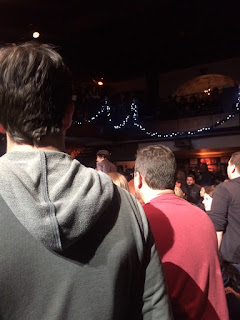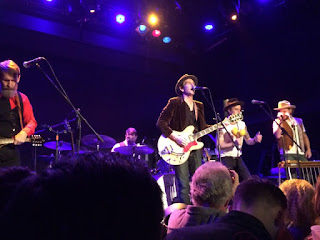Jeff Stein, longtime friend of Frank Zappa & family and co-producer of the new concert film
Roxy: The Movie, referred to the era when the film was lensed and recorded as a "magical time". "This was a time in which everyone played instruments and not turntables."
For that and other reasons, some of the Marshall McLuhan, Children's Television Workshop, and eMpTyV Networks generation may find
Roxy: The Movie and Zappa's music in general to be boring or unwatchable. Those who are not as culturally and aesthetically deprived would find tremendous value in them.
The film, scheduled for DVD and Blu-Ray release on October 30, is a superlative achievement of post-production after a less-than-superlative production. Three or four concerts were filmed (on 16mm film) and recorded (on sixteen tracks) at The Roxy in West Hollywood in December 1973. (Exactly when the shows took place, and what was recorded, is unclear. The film's credits indicate the film was shot December 8-10, 1973. The filmmakers assert that four concerts plus a soundcheck or two on separate days were filmed.
A comprehensive Frank Zappa Gig List on the Internet presents equivocal, uncertain information. It is possible more than one show was played on some of the dates and/or that one of the filmed concerts was not used. Problems with the source material delayed release for several decades.)
Last night, the American Cinematheque hosted an event at the historic Grauman's Egyptian Theatre in Hollywood. Unfortunately, Zappa's widow Gail (co-producer of the film) died last week. However, son Ahmet (who also co-produced the film), Jeff Stein, editor-coproducer John Albanian, Zappa "Vaultmeister" Joe Travers, Alex Winter (an actor/director who is making a documentary about Zappa), and musicians Ralph Humphrey and Bruce Fowler (both of whom appear prominently in the movie) participated in a panel discussion after the screening of the ninety-five minute film.
Some of the following may include "spoilers" for those who plan to see the film and want to be surprised at its content.
Some of the content is familiar in audio form. Zappa released the double album and fan favorite
Roxy & Elsewhere (DiscReet) in 1974. As the title suggests, it contains live performances recorded at the Roxy (in December 1973) and elsewhere. Many of the recordings from the Roxy were extensively edited and overdubbed during post-production. This film obviously contains moments audible on the album--but they are in their raw, unedited and untouched state here. Seeing the film footage accompanying the familiar audio recordings is quite a vivid, borderline magical experience for fans of the album. Seeing the footage projected on the Egyptian's gargantuan screen with a nearly-full audience of a Zappa fans applauding is as close as one could get to being present during the historic performances.
In December 1973, the Mothers including drummer Humphrey, drummer Chester Thompson, auxiliary percussionist Ruth Underwood, trombonist Fowler, bass guitarist Tom Fowler (Bruce's brother), keyboardist/vocalist George Duke, and saxophonist/vocalist Napoleon Murphy Brock. Many fans consider this to be one of Zappa's finest ensembles (which is saying something. To see them playing and improvising together on the Roxy's cramped stage, with a shiny curtain backdrop (it looks almost like gold lamé), is a revelation, even on film. Even disinterested spectators could not fail to notice and appreciate the immaculately rehearsed, intricate, disciplined, virtuosic nature of a Frank Zappa concert. It is a standard of discipline and professionalism that has mostly disappeared from the culture. The 16mm footage is not particularly detailed or high resolution, and the cinematography is borderline amateurish at times. It is a more-than-adequate, fascinating, and priceless document nonetheless (and a near-miracle that it exists in this form, as the filmmakers discussed after the screening).
Some of the audio highlights:
---The opening moments of
Roxy & Elsewhere (Zappa's amusing spoken introduction to "Penguin In Bondage") are seen and heard in the film. [It is possible--even likely--that the performance(s) in the film do not entirely match those on the album, as many pieces in the film contain elements of more than one performance.] Those familiar with the album will notice just how much the tune was edited and overdubbed during postproduction.
---"Echidna's Arf (Of You)" and "Don't You Ever Wash That Thing?" are strikingly different from the album versions. "Echidna's Arf" does not segue out of "Village of the Sun" (missing from the film) but starts as a standalone. The "watch Ruth" section (which differed during every performance) is different.
---"Cheepnis", referred to at one point as "A Little More Cheepnis Please", is preceded by a performance of part of the song with drums and percussion only. (Humphrey has no recollection of them performing the song this way, which means it may have been a one-off performance.) It is instantly recognizable to those familiar with the paean to low-grade horror and science fiction B-movies. Subsequently, a lengthier iteration of Zappa's spoken introduction from the album is seen and heard.
---Significant portions of the album's long closing tune, "Be-Bop Tango (of the Old Jazzmen's Church)", and its audience participation elements, are seen and heard in the film.
---Several tunes absent from the album, old and then-new, are in the film. "Cosmik Debris" and "Inca Roads" were works in progress at the time and differ considerably from their soon-to-be-released, familiar versions. (The latter is fortunately missing the odd "guacamole queen" lyrics.) Humphrey and Fowler think that the version of "Inca Roads" in the film was the "second" version (they called it the "cocktail version").
Some of the video highlights:
---It is instructive to note which drum parts were played by Humphrey and which were played by Thompson (who is now best known as a touring drummer for Genesis and Phil Collins).
---Underwood has a significant amount of drums behind her, despite her reputation as being primarily a vibes/xylophone player. At times, she is, in effect, a third drummer.
---During "Dog Meat" (an amalgam of "Dog Breath" and "Uncle Meat"), Zappa plays Underwood's drums for a significant amount of time.
---At times, it appears that Humphrey reaches over to Underwood's instruments from his drum throne and plays some of them. He steps up from the throne and joins Underwood behind her setup during one tune.
---Zappa's facial expression during the spoken interlude in "Cheepnis" (also familiar from the album) is essential.
---Zappa's use of his wah-wah pedal was often subtle. Thanks to the visuals, it is always obvious when he used it.
---The close-ups of Zappa's sneakers are notable if trivial. During the discussion period, Travers related that they were painted by Carl Franzoni (who is known from the liner notes to
Freak Out!, the Mothers of Invention's 1966 Verve debut).
---The odd, communal, unmistakably Zappa event that is "Be-Bop Tango" is a visual testament to the cliché that a picture is worth a thousand words. It isn't fully comprehensible (or close to enjoyable) until seen and arguably should have been left off the album.
I heard the following tunes in the film (in this order): "Cosmik Debris", "Penguin in Bondange", "Dog Meat", an audience participation interlude, "Inca Roads", "Echidna's Arf (Of You)", "Don't You Ever Wash That Thing?", "Cheepnis" (percussion only), "Cheepnis", "I'm the Slime", "Big Swifty", and "Be-Bop Tango (of the Old Jazzmen's Church)". I think I saw "Dupree's Paradise" listed in the credits (somewhere around "Dog Meat"), but I didn't notice it in the film. The trailer includes part of "Dickie's Such an Asshole", which is not in the film. [An encore performance of the song from one of these shows was released on
You Can't Do That On Stage Anymore: Vol. 3 (Rykodisc) in 1989.]
After the screening, the assembled panel discussed the film and the tribulations involved with getting it into released form. Due to a failure of the Roxy's intercom system that occurred right before the first show that was not noticed until after the film was processed, the visuals and audio were out of sync. It was not possible to fix this digital technology advanced (long after Zappa's 1993 death). Co-producer Stein and editor/co-producer Albarian discussed the limitations of the source material and the challenges syncing all of it up. At some point within the last twenty years, the 16mm footage was transferred to HDCam. (Zappa had produced and mixed all of the audio recordings much earlier, anticipating an eventual release.) For some of the audio, only one camera feed was available. Often, it was a closeup on Zappa's face while another musician (e.g., Bruce Fowler) was soloing. For other segments, no cameras were rolling. Stein remarked, "It really was a miracle that it came together, but we do have a happy ending. We love happy endings." He also related how many tunes contain parts of multiple performances. "There's a lot of cheating going on." He added that the intricate nature of the music made it exceptionally challenger to "cheat". (I would have preferred unedited performances without cutting in the middle of a song, but Zappa himself frequently cut mid-song during his own live recordings. So it is, at the very least, consistent, and perhaps necessary given the limitations of the source material. Zappa and the Mothers wore the same clothes during all performances to facilitate an integrated, smooth viewing experience.) Humphrey was emphatic that the effect is that of the illusion of a complete, unedited, single concert: "It looks like it was a complete concert. No edits." It's hard to argue with him.
Winter and Travers answered some questions about the contents of the Zappa vaults and some of the material left out of the film. (Winter, who is making a documentary about Zappa, is best known for playing Bill S. Preston in
Bill and Ted's Excellent Adventure and
Bill and Ted's Bogus Journey. Travers is a drummer who previously played with Dweezil Zappa's ongoing Zappa Plays Zappa project.) He opined that this footage was "the Muhammad Ali of the vaults" ("the greatest"). "Village of the Sun" was left off because all of the available footage and performances were lackluster. He added that the album version is heavily overdubbed: "for a good reason". He did concede that there's a possibility the original live version will be released at some point. When a member of the audience asked about the possibility of one complete, unedited Roxy concert (or all of them) being released on CD, both Zappa and Travers concurred that it was a possibility. This is encouraging (and could finally solve the mystery of exactly how many shows were played at the Roxy in December 1973). Zappa (who was in utero in December 1973) reminisced about his parents (he was remarkably composed and dignified for someone who experienced such a monumental loss last week). One of his anecdotes (which occurred long before he was born) related that Zappa gave Jimi Hendrix his first wah-wah pedal. He thanked everyone for being present and noted the support the family had been receiving. (His sister Diva was apparently in the audience.) Humphrey and Fowler reminisced about playing and rehearsing with Zappa. One highlight: When asked who decided which drummer would play which parts, he answered that Zappa made about half of the decisions and Thompson and himself made the rest. Fowler talked about his film scoring work and shared that he borrowed aspects of Zappa's unique conducting style when he leads ensembles during film score recording sessions.
The filmmakers noted that the moment when the cover photograph of
Roxy & Elsewhere was taken can be seen in
Roxy: The Movie. This is just one reason that the DVD/Blu Ray purchase is essential for anyone who treasures
Roxy & Elsewhere (warts and all). And the vivid, fly-on-the-wall footage (warts and all) is essential for anyone who treasures Frank Zappa and all he represents.
 |
| Left to right: Alex Winter, Ahmet Zappa, Jeff Stein, John Albarian, Joe Travers, Ralph Humprhey, and Bruce Fowler. Fowler's T-shirt is printed with the legend, "Stop Plate Tectonics". |



















